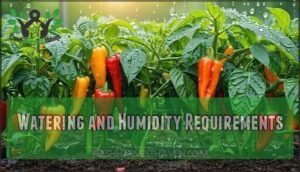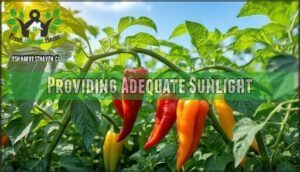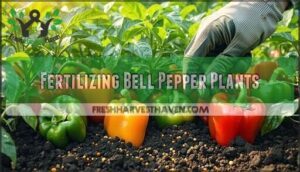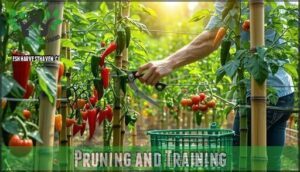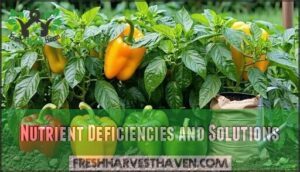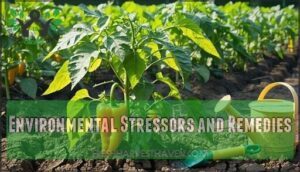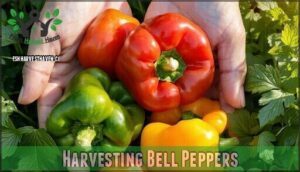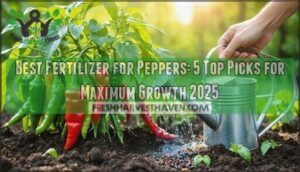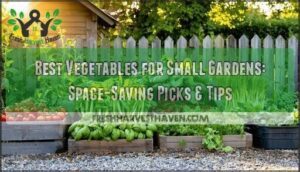This site is supported by our readers. We may earn a commission, at no cost to you, if you purchase through links.
 Learning how to grow bell peppers starts with choosing the right spot and timing.
Learning how to grow bell peppers starts with choosing the right spot and timing.
Plant your seedlings after the last frost in well-draining soil enriched with compost.
Space them 18-24 inches apart in full sun, ensuring they get 6-8 hours of daily sunlight.
Water consistently but don’t overdo it—soggy roots spell trouble.
Feed them with balanced fertilizer every few weeks once flowering begins.
Think of peppers as sun-worshippers who appreciate steady moisture and good nutrition.
Most varieties take 70-80 days to mature from transplant.
The secret lies in understanding their specific needs for temperature, spacing, and nutrient timing throughout the growing season.
Table Of Contents
- Key Takeaways
- Growing Bell Peppers
- How to Grow Bell Peppers
- Bell Pepper Plant Care
- Common Bell Pepper Problems
- Harvesting Bell Peppers
- Frequently Asked Questions (FAQs)
- How do you grow bell peppers for beginners?
- Do bell peppers grow better in pots or in the ground?
- What is the secret to growing bell peppers?
- What does Epsom salt do for pepper plants?
- Can bell peppers be grown indoors year-round?
- How long do bell pepper plants typically live?
- Are bell peppers safe for pets to eat?
- What companion plants grow well with bell peppers?
- Can you save seeds from store-bought bell peppers?
- Conclusion
Key Takeaways
- Start your pepper seeds indoors 8-10 weeks before the last frost, then transplant them outside when soil temperature reaches 60°F and you’re past the frost danger – this timing is crucial for successful bell pepper growing.
- Plant your seedlings 18-24 inches apart in well-draining soil with a pH between 6.0-6.8, ensuring they’ll get 6-8 hours of direct sunlight daily since peppers are sun-worshippers that need consistent warmth.
- Water deeply but infrequently 2-3 times weekly, checking that the top inch of soil is dry before watering – soggy roots will kill your plants faster than drought conditions.
- Feed your plants with balanced 10-10-10 fertilizer every 4-6 weeks once they reach 6-8 inches tall, then switch to low-nitrogen blends during fruit production to maximize your pepper harvest.
Growing Bell Peppers
Growing bell peppers successfully requires understanding three essential elements: selecting the right variety for your climate, preparing nutrient-rich soil with proper drainage, and starting seeds at the correct time.
You’ll need to weigh factors like days to maturity, disease resistance, and whether you’re growing in containers or garden beds to guarantee your pepper plants thrive from seedling to harvest, considering the importance of complete concepts.
Choosing Bell Pepper Varieties
Selecting the right bell pepper varieties sets the foundation for your garden’s success.
With over 200 varieties available, you’ll want to evaluate several key factors before making your choice.
Choose wisely from 200+ varieties—your pepper garden’s success starts with the right selection for your unique growing conditions.
When choosing bell pepper varieties for cultivation, evaluate these essential characteristics:
- Pepper Color – Green, red, yellow, orange, and purple varieties offer different flavor profiles and maturity stages
- Plant Size – Compact varieties work well for containers while larger plants suit garden beds
- Disease Resistance – Hybrid cultivars provide better protection against common pepper plant diseases
- Yield Potential – Select varieties known for producing 5-10 peppers per plant for maximum harvest
Consider sweetness levels and growing conditions when selecting bell pepper seedlings for ideal results.
Some gardeners prefer the sweet taste of varieties like Pimento or Orange Sun.
Preparing Soil for Planting
Your bell pepper success starts below ground.
Strong roots create sweet peppers—your garden’s foundation determines your harvest’s flavor.
Test your soil pH first – peppers thrive between 6.0-6.8.
Mix compost into clay soils for drainage improvement, while sandy soils need organic matter for nutrient retention.
Well-draining soil prevents root rot, the silent killer of bell pepper seedlings.
Accurate readings are achievable with a reliable testing device.
| Soil Factor | Ideal Range | Testing Method | Amendment Options | Timeline |
|---|---|---|---|---|
| Soil pH | 6.0-6.8 | Digital meter/strips | Lime (raise) or sulfur (lower) | 2-4 weeks |
| Drainage | 1-2 inches/hour | Water percolation test | Compost, perlite, raised beds | Immediate |
| Organic Matter | 3-5% content | Lab analysis | Compost, aged manure | 2-3 weeks |
| Nutrient Balance | N-P-K 10-10-10 | Soil testing kit | Balanced fertilizer | 1-2 weeks |
| Soil Temperature | 65-75°F | Thermometer | Black plastic mulch | 1 week |
Sowing Bell Pepper Seeds
With your soil prepared, you’re ready to start your bell pepper seeds.
Use a quality seed starting mix and plant seeds ¼-inch deep in small containers.
Maintain germination temperature between 70-80°F for best results.
Indoor sowing should begin 8-10 weeks before your last frost date.
This timing guarantees proper transplant timing when outdoor conditions become favorable for growing bell peppers successfully.
How to Grow Bell Peppers
Why settle for store-bought peppers when you can cultivate vibrant bell peppers right in your backyard? Growing bell peppers successfully requires understanding their specific needs and preferences. These warm-season vegetables thrive in temperatures between 70-80°F and need consistent moisture without waterlogged conditions.
Container Growing offers flexibility for gardeners with limited space, allowing you to move plants to ideal locations. Choose containers at least 12 inches deep with drainage holes. Companion Planting with basil, tomatoes, or marigolds can improve growth and deter pests naturally.
Consider these essential growing factors:
- Temperature control: Protect plants when temperatures drop below 60°F
- Spacing requirements: Allow 18-24 inches between plants for proper air circulation
- Organic Methods: Use compost and natural fertilizers to build healthy soil
Pepper Pollination occurs naturally through wind and insects, though hand-pollination can increase yields. Start Seed Saving from your best-performing plants to develop varieties suited to your specific growing conditions.
Bell Pepper Plant Care
Once your bell pepper plants are established, consistent care guarantees healthy growth and maximum fruit production.
You’ll need to maintain proper watering schedules, provide adequate sunlight exposure, apply balanced fertilizers, and perform strategic pruning to optimize your harvest.
Watering and Humidity Requirements
Water your bell peppers deeply but infrequently to maintain consistent soil moisture without waterlogging.
Check the top inch of soil—if it’s dry, it’s time to water. Aim for watering frequency of 2-3 times weekly, adjusting for weather conditions.
Watch for overwatering signs like yellowing leaves or underwatering signs like wilting. Maintain humidity levels around 50-70% for ideal pepper plant care.
Efficient watering also prevents unnecessary moisture loss and supports overall pepper plant care with proper watering frequency.
Providing Adequate Sunlight
Like solar panels craving energy, your bell pepper plants need 6-8 hours of direct sunlight daily for ideal pepper plant care.
Morning sun works best, providing ideal light intensity and perfect spectrum for photosynthesis.
In hot climates, afternoon shading effects prevent stress while maintaining bell pepper sunlight requirements.
Consider artificial lighting indoors to supplement natural light during shorter days for successful bell pepper cultivation.
Fertilizing Bell Pepper Plants
Proper fertilizing peppers transforms average harvests into abundant yields. Bell pepper fertilizer with balanced nutrient ratios feeds your plants perfectly.
Conduct soil testing before applying organic fertilizers to identify deficiency symptoms early. Optimal soil pH promotes nutrient absorption.
- Start fertilizing when plants reach 6-8 inches tall
- Apply balanced 10-10-10 fertilizer every 4-6 weeks
- Switch to low-nitrogen blends during fruit production
- Monitor for yellowing leaves indicating fertilizer timing adjustments
Pruning and Training
Strategic pruning techniques transform your bell pepper plants into productive powerhouses.
Remove suckers between main stems and pinch early flowers to redirect energy toward robust growth.
Training methods using bamboo stakes or tomato cages create essential support structures for heavy fruit production.
Proper pepper plant spacing allows air circulation, promoting plant health and maximizing bell pepper yield throughout the growing season to ensure productive powerhouses.
Common Bell Pepper Problems
Even the most carefully tended bell pepper plants can face challenges from pests, diseases, and environmental stress that threaten your harvest.
Understanding these common problems and their solutions will help you identify issues early and take corrective action to keep your pepper plants healthy and productive.
Pests and Diseases Affecting Bell Peppers
Bell pepper problems often stem from unwelcome visitors and infections.
Aphids cluster under leaves, while thrips damage plant tissue.
Fungal diseases thrive in humid conditions, causing leaf spots and fruit rot.
Viral infections spread through insect vectors, stunting growth.
Blossom-end rot appears as dark, sunken spots on fruits.
Effective pest prevention and organic pepper growing methods help maintain healthy plants.
Controlling aphid infestations is essential for healthy bell peppers, which is crucial for healthy bell peppers.
Nutrient Deficiencies and Solutions
Identifying deficiencies starts with soil testing to reveal pH and nutrient levels.
The best soil for peppers requires balanced nitrogen, phosphorus, and potassium.
Organic amendments like compost correct deficiencies naturally, while specific fertilizer types target individual problems.
Deficiency prevention involves regular monitoring and proper watering of bell peppers to maintain nutrient uptake and prevent common bell pepper problems.
Environmental Stressors and Remedies
When temperature extremes, water stress, and soil issues hit your pepper plants, they’ll show clear distress signals.
Watch for wilting, stunted growth, or yellowing leaves that signal trouble brewing.
- Temperature Extremes: Shield plants from scorching heat above 85°F or chilling below 50°F using shade cloth or row covers
- Water Stress: Maintain consistent moisture without waterlogging—dry soil kills faster than you’d think
- Soil Issues: Test pH levels between 6.0-6.8 for ideal nutrient uptake
- Light Imbalance: Guarantee 6-8 hours of direct sunlight daily for healthy development.
Addressing these issues promptly can prevent common plant diseases.
Harvesting Bell Peppers
You’ll know your bell peppers are ready to harvest when they reach full size and develop their mature color, whether that’s green, red, yellow, or orange depending on the variety.
Proper timing and gentle handling during harvest will guarantee you get the best flavor and longest storage life from your homegrown peppers.
Determining Optimal Harvest Time
Perfect timing makes all the difference when harvesting bell peppers.
Color Maturity is your best guide—green peppers can be picked early, while red, yellow, or orange varieties need full color development.
Size Matters too; peppers should feel substantial in your hand.
The Firmness Test reveals readiness—ripe peppers feel solid, not soft.
Taste Testing confirms sweetness has developed properly.
For best results, harvest when the skin shows gloss.
Handling and Storing Bell Peppers
Once you’ve mastered harvesting bell peppers at peak ripeness, proper handling prevents bruising and extends shelf life.
Store fresh peppers in your refrigerator’s crisper drawer at 45-50°F for ideal storage temperature. They’ll stay crisp for 1-2 weeks when avoiding spoilage through proper air circulation.
For long-term preservation, try freezing peppers after blanching to maintain their nutritional value and texture.
Using Bell Peppers in Various Recipes
After proper handling and storage, your homegrown bell peppers shine in countless recipes.
Create colorful Bell Pepper Salads with crisp slices, or prepare hearty Stuffed Bell Peppers filled with rice and meat.
Blend roasted peppers into rich Bell Pepper Sauces, toss them in quick Bell Pepper Stir-fries, or top your homemade Bell Pepper Pizza.
Each variety offers unique flavors for your culinary adventures.
Frequently Asked Questions (FAQs)
How do you grow bell peppers for beginners?
Think you’ll just toss seeds and hope for the best?
You’ll need warm soil, full sun, and consistent watering.
Start seeds indoors six weeks before last frost, then transplant outside when soil reaches 60°F.
Do bell peppers grow better in pots or in the ground?
Bell peppers thrive in both environments, but ground planting typically yields larger harvests with deeper root systems.
However, containers offer better pest control and mobility.
Choose based on your space, soil quality, and gardening preferences.
What is the secret to growing bell peppers?
Like nurturing a green treasure chest, you’ll achieve bell pepper success through consistent warmth, deep watering, and rich soil.
Feed them calcium, provide sturdy support, and they’ll reward you with vibrant, crunchy gems.
What does Epsom salt do for pepper plants?
Epsom salt provides magnesium sulfate, which boosts chlorophyll production and helps your pepper plants absorb nutrients more efficiently.
You’ll notice greener leaves, stronger stems, and potentially better fruit development when applied monthly during growing season.
Can bell peppers be grown indoors year-round?
Yes, you can grow bell peppers indoors year-round with proper lighting, temperature control, and container gardening.
They’ll need at least 6-8 hours of bright light daily and temperatures between 65-75°F.
How long do bell pepper plants typically live?
While tomatoes die after one season, your bell pepper plants can surprise you by living 5-7 years with proper care.
They’re perennials that’ll keep producing if you protect them from frost and maintain good growing conditions, making them a worthwhile investment for proper care.
Are bell peppers safe for pets to eat?
Bell peppers are generally safe for dogs and cats in small amounts. They’re non-toxic and provide vitamins. However, remove seeds and stems first, and introduce gradually to avoid digestive upset.
What companion plants grow well with bell peppers?
Ironically, peppers that love heat thrive alongside cool-weather companions.
You’ll find basil, oregano, and parsley boost pepper growth while deterring pests.
Tomatoes, eggplant, and marigolds also make excellent neighbors in your garden beds, and they can be considered as cool-weather companions.
Can you save seeds from store-bought bell peppers?
You can save seeds from store-bought bell peppers, but they’re often hybrid varieties that won’t grow true-to-type.
Open-pollinated peppers work better.
Let seeds dry completely before storing in cool, dry conditions.
Conclusion
Success with how to grow bell peppers hinges on mastering the fundamentals you’ve learned.
Your plants will reward consistent care with vibrant, crisp peppers that’ll transform your kitchen creations.
Remember to monitor soil moisture, provide steady nutrition, and watch for early signs of stress.
With proper timing and attention to their sun-loving nature, you’ll enjoy abundant harvests throughout the growing season.
Start planning your pepper garden now—fresh, homegrown bell peppers await your dedication and patience.
- https://www.instagram.com/growfinancial/
- https://docs.google.com/forms/d/1GAQr3Kn1cURCVHUA82hAga1Wv8DCH0IuqDLRUrOpN7M/viewform?ts=63f4f653&entry.1515682415=https://www.merriam-webster.com/dictionary%2Fgrow
- https://premium.britannica.com/mw-unabridged/?utm_source=mw&utm_medium=inline-def&utm_campaign=evergreen
- https://www.freethesaurus.com/grow
- https://medical-dictionary.thefreedictionary.com/grow

